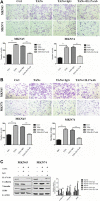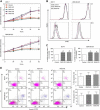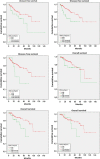The Research Progress on the Prognostic Value of the Common Hematological Parameters in Peripheral Venous Blood in Breast Cancer
- PMID: 32104003
- PMCID: PMC7028387
- DOI: 10.2147/OTT.S227171
The Research Progress on the Prognostic Value of the Common Hematological Parameters in Peripheral Venous Blood in Breast Cancer
Abstract
Breast carcinoma is one of the most malignant tumors, severely influencing the physical and mental health of people. The latest epidemiological and clinical studies have found that breast tumor and inflammation are determinate relationships with each other. Inflammation is an essential component of the tumor microenvironment, and the change of inflammatory cells might influence tumor progression, such as neoplastic cell proliferation, migration, invasion, the collapse of antitumor immunity, metastasis and so forth. Peripheral blood tests at the time of diagnosis and treatment can reflect inflammatory conditions within the neoplasm. Evaluation of peripheral blood parameters including white blood cell, neutrophil, lymphocyte, monocyte, platelet counts, as well as neutrophil-to-lymphocyte ratio (NLR), derived neutrophil-to-lymphocyte ratio (d-NLR) (neutrophil count divided by the result of white blood cell count minus neutrophil count), platelet-to-lymphocyte ratio (PLR) and lymphocyte-to-monocyte ratio (LMR), which are indicators of systematic inflammatory response, have been widely proposed as prognostic factors for many malignancies. To intensively study the relationship between the common markers in peripheral blood and the treatment or prognosis of breast cancer will have critical clinical significance and application prospect, and can provide useful information for the clinicians. Herein, we review the research progress in the prognostic role of the peripheral blood in breast cancer to provide a new method for the treatment and prognosis of breast cancer.
Keywords: LMR; NLR; PLR; breast cancer; lymphocyte-to-monocyte ratio; neutrophil-to-lymphocyte ratio; platelet to lymphocyte ratio; prognosis.
© 2020 Chen et al.
Conflict of interest statement
The authors declare that they have no competing interests.
Figures





Similar articles
-
Preoperative Neutrophil-Lymphocyte Ratio, Platelet-Lymphocyte Ratio and Lymphocyte-Monocyte Ratio in Peripheral Blood of Patients with Gastrointestinal Malignant Lesions.Curr Health Sci J. 2019 Jul-Sep;45(3):285-290. doi: 10.12865/CHSJ.45.03.06. Epub 2019 Sep 30. Curr Health Sci J. 2019. PMID: 32042456 Free PMC article.
-
COMPLETE BLOOD COUNT DERIVED INFLAMMATORY BIOMARKERS IN PATIENTS WITH HEMATOLOGIC MALIGNANCIES.Georgian Med News. 2020 May;(302):39-44. Georgian Med News. 2020. PMID: 32672687
-
Complete Blood Count Score Model Integrating Reduced Lymphocyte-Monocyte Ratio, Elevated Neutrophil-Lymphocyte Ratio, and Elevated Platelet-Lymphocyte Ratio Predicts Inferior Clinical Outcomes in Adult T-Lymphoblastic Lymphoma.Oncologist. 2019 Nov;24(11):e1123-e1131. doi: 10.1634/theoncologist.2018-0789. Epub 2019 Apr 5. Oncologist. 2019. PMID: 30952822 Free PMC article.
-
[Research progress of peripheral blood count test in the evaluation of prognosis of gastric cancer].Zhonghua Wei Chang Wai Ke Za Zhi. 2017 Feb 25;20(2):236-240. Zhonghua Wei Chang Wai Ke Za Zhi. 2017. PMID: 28226360 Review. Chinese.
-
Preoperative Neutrophil Lymphocyte Ratio Can Be Used as a Predictor of Prognosis in Patients With Adenocarcinoma of the Esophagogastric Junction: A Systematic Review and Meta Analysis.Front Oncol. 2020 Feb 21;10:178. doi: 10.3389/fonc.2020.00178. eCollection 2020. Front Oncol. 2020. PMID: 32154173 Free PMC article.
Cited by
-
A novel machine learning prediction model for metastasis in breast cancer.Cancer Rep (Hoboken). 2024 Mar;7(3):e2006. doi: 10.1002/cnr2.2006. Cancer Rep (Hoboken). 2024. PMID: 38425238 Free PMC article.
-
Comparison of Hematological Parameters and the Associated Factors Among Women with and without Breast Cancer: A Case-Control Study.Breast Cancer (Dove Med Press). 2024 Dec 10;16:877-885. doi: 10.2147/BCTT.S497313. eCollection 2024. Breast Cancer (Dove Med Press). 2024. PMID: 39678025 Free PMC article.
-
The association and clinical significance of hematological biomarkers in ankylosing spondylitis.Sci Rep. 2025 May 6;15(1):15755. doi: 10.1038/s41598-025-99274-4. Sci Rep. 2025. PMID: 40328909 Free PMC article.
-
Diagnostic and prognostic role of NLR in testicular cancer.Explor Target Antitumor Ther. 2024;5(6):1177-1198. doi: 10.37349/etat.2024.00270. Epub 2024 Sep 19. Explor Target Antitumor Ther. 2024. PMID: 39465013 Free PMC article.
-
Novel serological biomarkers for inflammation in predicting disease severity in patients with COVID-19.Int Immunopharmacol. 2020 Dec;89(Pt A):107065. doi: 10.1016/j.intimp.2020.107065. Epub 2020 Oct 3. Int Immunopharmacol. 2020. PMID: 33045571 Free PMC article.
References
Publication types
LinkOut - more resources
Full Text Sources

